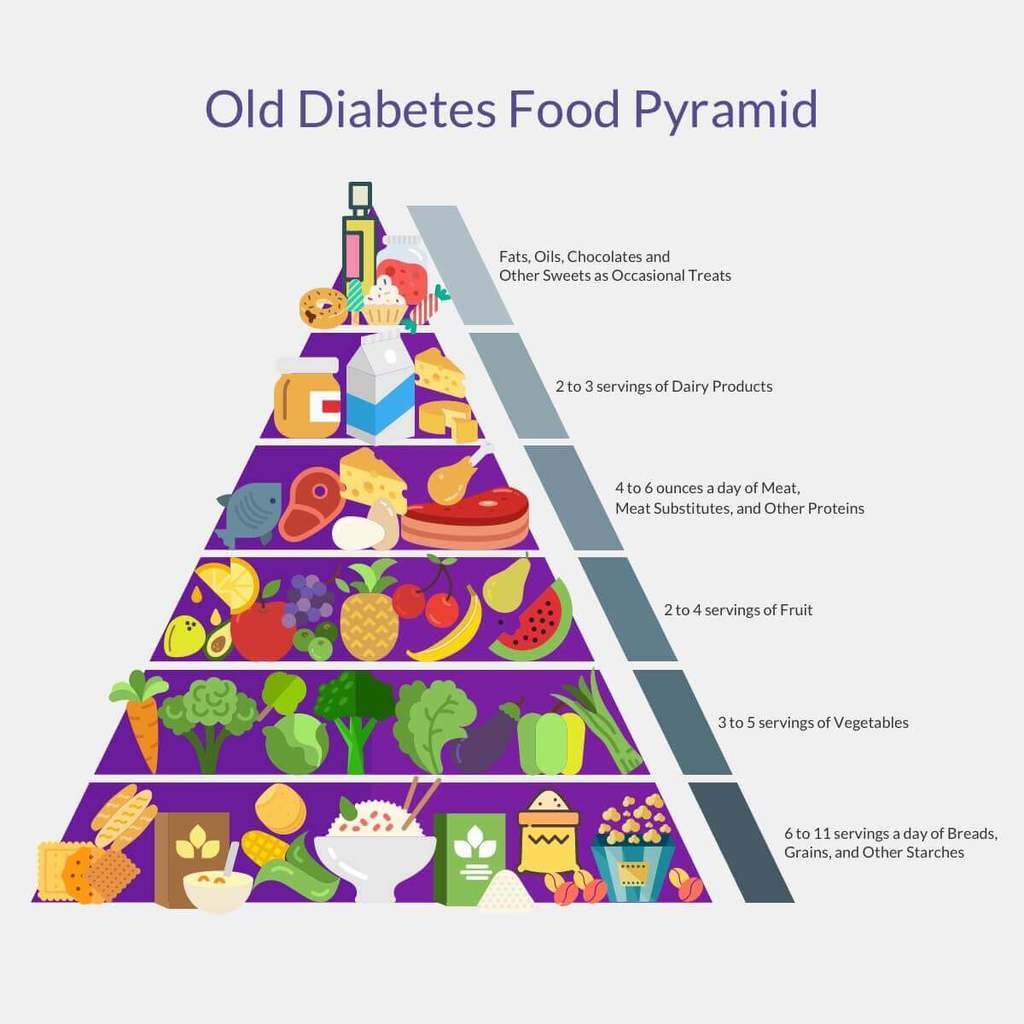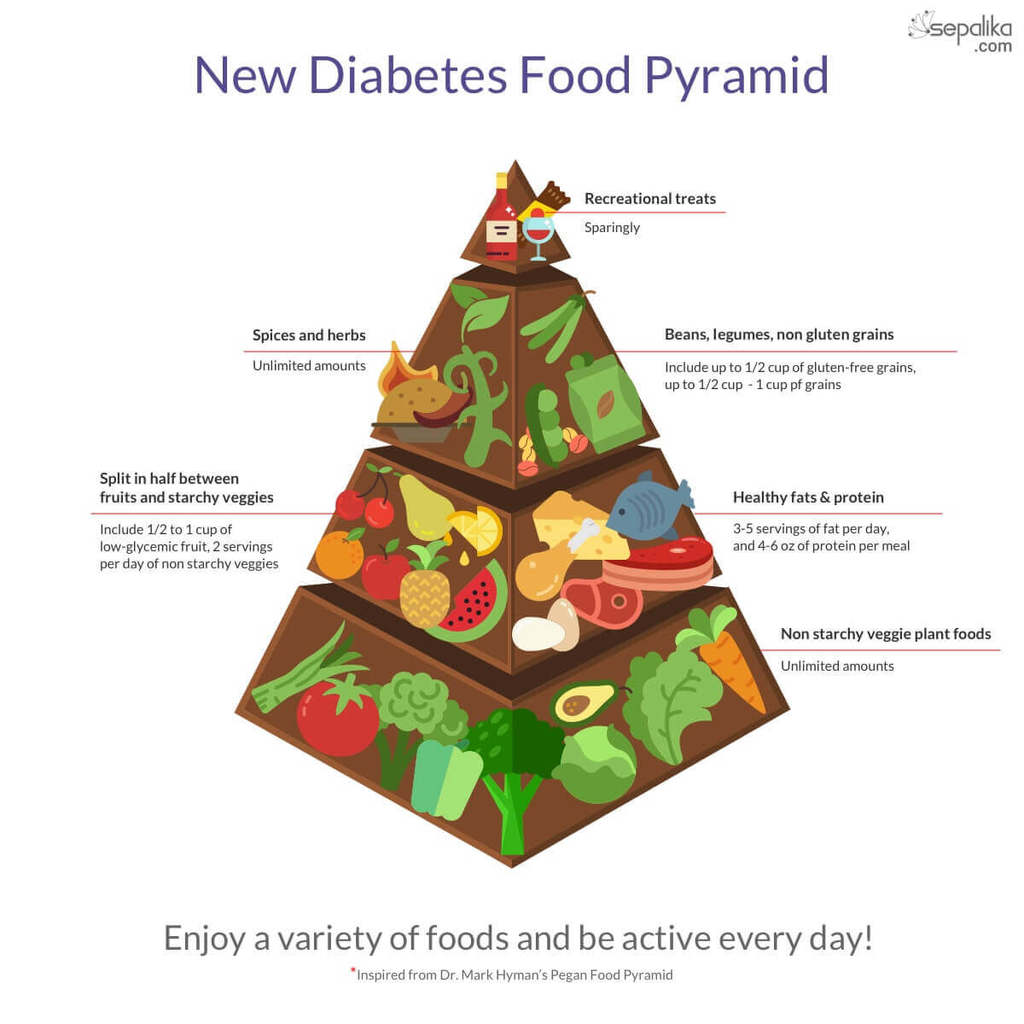Diet plays an important role in the treatment of diabetes, as well as in the prevention of prediabetes progressing into type 2 diabetes. But, not many people know what is right and what is wrong when it comes to food and diabetes.
That’s why the American Dietetic Association and the American Diabetes Association have created the Diabetes Food Pyramid.
The pyramid shows the foods and the amount you should eat daily. It has six food groups and the wider the section, the larger portion should be consumed from that particular food group.
On the opposite, foods at the top, which is a narrower section, should be eaten in smaller amounts.
Does the Old Diabetic Food Pyramid Make Sense Anymore?
This is the traditional food pyramid for diabetes, starting from the bottom.
Once you see it, you’ll realize there’s something wrong with the foods and their position in the pyramid.
- Bread, grains, and other starches – 6-11 servings a day;
- Vegetables – 3-5 servings;
- Fruit – 2-4 servings;
- Dairy Products – 2-3 servings;
- Meat, meat substitutes, and other sources of proteins – 4-6 ounces a day;
- Oils, fats, chocolates, and other occasional sweet treats.
As we can see, the bottom includes a lot of carbohydrates, and a person with diabetes shouldn’t eat that many carbs every day. So, there’s the main problem with the traditional diabetes food pyramid.
A lot of doctors, including Dr. Fung, are recommending the LCHF diet (low-carbohydrate high-fat diet) for weight loss and diabetes management.
Many studies, including Forbes, show that combining good fats with low carbs can improve insulin resistance, cholesterol numbers, and weight loss in obese people with type 2 diabetes.
Another study supports the consumption of nuts, vegetables, a Mediterranean diet for the prevention of Coronary Heart Disease.
What’s more, it discovered that consuming foods with a high GI or glycemic load, as well as trans fats, raises the risk of heart disease.
The reason why we mention this research is that the traditional food pyramid for diabetes puts fats at the top of the food pyramid, thus restricting them.
However, the U.S. government removed cholesterol and good fats from the ‘villain’ list in 2016. High-quality fats are good for heart health so they must be part of the diabetes diet in larger amounts.
The limited portions of cheese, eggs, red meat, and no added sugars in the low-carbohydrate high-fat diet resemble the Mediterranean diet.
A few studies have shown that the Mediterranean diet is excellent for diabetes as much as it is for weight loss.
The Ideal Diabetes Food Pyramid
When you think about it, it’s pretty obvious why low-carbohydrate diets help manage type 2 diabetes. They break down into sugars that go into the blood, causing blood sugar spikes.
Therefore, a reduction in carbohydrates can help stabilize blood glucose levels. That’s why many doctors like the Pegan Food Pyramid designed by Dr. Mark Hyman.
Here’s how the LCHF food pyramid for diabetes looks like, from bottom to top:
- Plant foods and non-starchy vegetables you can consume in unlimited amounts;
- Healthy fats – 3-5 servings a day; proteins – 4-6 ounces (for example, eggs for breakfast, turkey or roasted chicken for lunch, and salmon to finish the day. Beans and tofu are excellent proteins for vegans;
- Low-glycemic fruits (cherries, pears, oranges, apples, strawberries, and plums) – ½-1 cup a day; non-starchy vegetables (artichokes, asparagus, broccoli, lettuce, squash, zucchini, celery, and cucumber) – 2 servings a day;
- Whole grains – ½ a cup; Beans – 1 cup maximum;
- Herbs and spices in unlimited amounts;
- Alcohol and desserts only occasionally.
Many people with type 2 diabetes have followed this diet along with intermittent fasting to improve their blood glucose control.
Combining this diabetes food pyramid with regular exercise/physical activity, and stress management techniques are the winning combination for every person with type 2 diabetes.
Tips for the New Diabetic Food Pyramid
- Pay attention to the portion sizes when following the diabetes food pyramid. A good way to feel fuller without starving yourself is adding more healthy fat to each of your meals;
- Fruits contain sugar, so make sure you don’t eat too much of it. Even better, consult the doctor or dietitian to see how much of the favorite fruit to consume daily;
- Add non-starchy veggies to the daily diets, such as carrots, spinach, green beans, and broccoli;
- Do not cut out carbs completely out of your diet, just limit their amount. Consume quinoa, brown rice, and other whole-grain foods in permitted portions;
- Add lentils, pinto, or kidney beans to the diet;
- Eat fish instead of meat 2-3 times weekly for healthy proteins. If you prefer meat, choose lean meats such as turkey or chicken. Consume red meat only occasionally;
- Remember to mix up the sources of proteins since each type offers a different combination of nutrients. Cheese, yogurt, milk, and similar dairy products contain calcium and other minerals and vitamins, and they are alternatives to protein.
We hope these tips will help you adjust your diet in a way that will help you prevent and treat type 2 diabetes.



